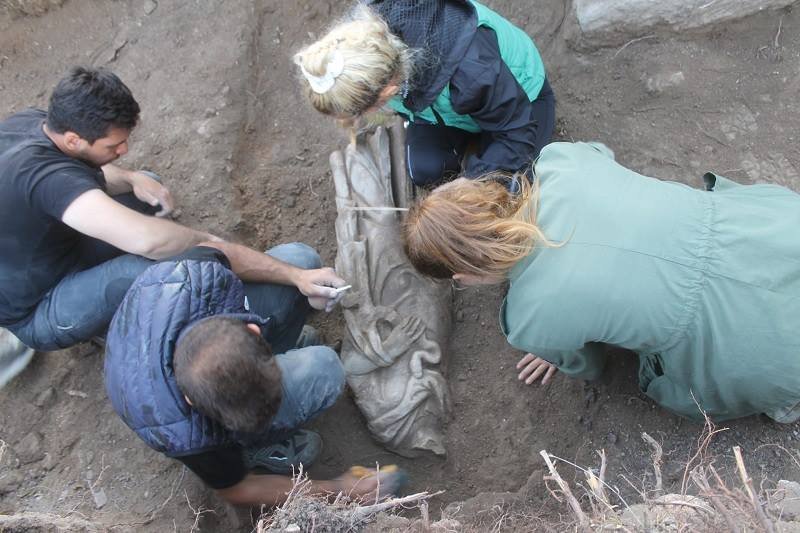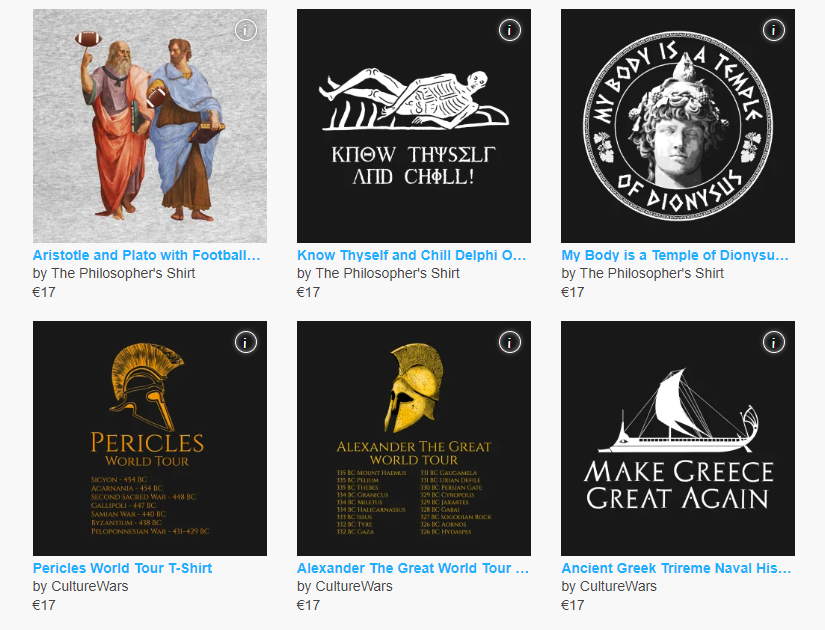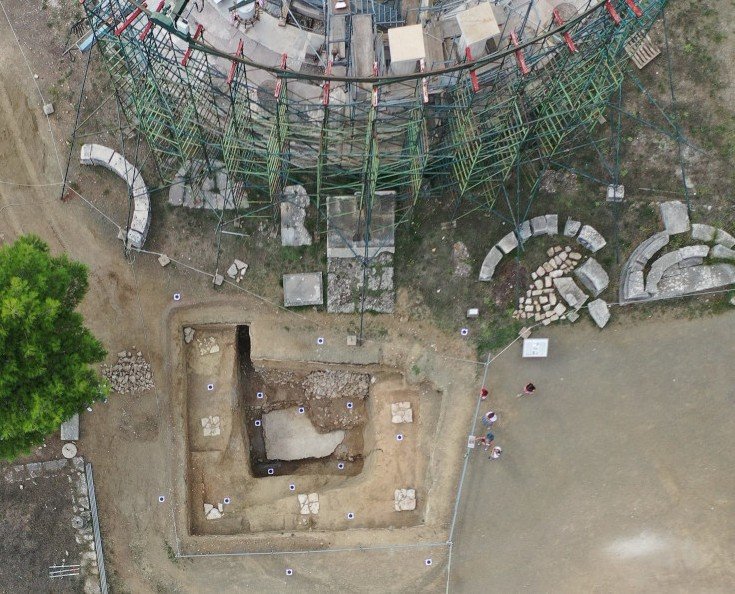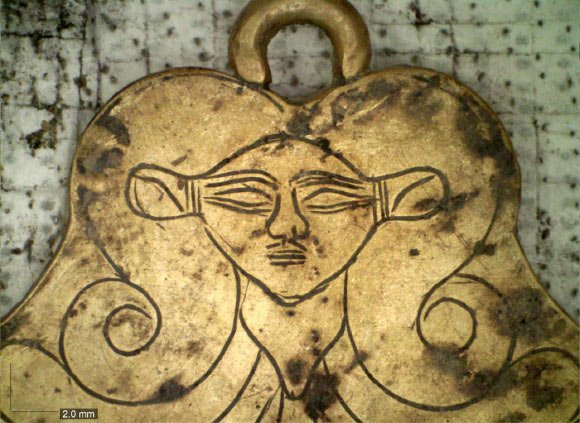This page and the next is intended as a mix of recent news about archeological discoveries in Greece (including ancient Greeks now in other countries) and the webmaster’s relevant discoveries on the internet. Posts are in reverse chronological order. Items about ancient Greece of general interest are found on the Ancient Greece Interest page.
Another Theater Along the Aegean

Aerial view of the Ancient Greek 2,400-year-old, 12,000-seat theatre at the Alexandria Troas Ancient City in Dalyan, Canakkale, Türkiye, on October 7, 2024. (IHA Photo)
In an ancient city and region that has had many names over the eons yet another large theater has been recently discovered. Now known as Çanakkale, Turkey and once near Troy this site is estimated to be from the 4th century B.C. Read details here in the Greek City Times.
Newly discovered trove of seal impressions

The clay impressions were found in the municipal archive of Doliche, an ancient Greek city now in Turkey. Details in this Greek Reporter article
Read about many ancient Greek cities now in Turkey on this page: When Turkey Was Greek
“New Poseidon Temple”

Actually dating back to before 800 BC this temple was referenced by the ancient geographer Strabo but just located and partially excavated this year. The site is near Elis on the western coast of the Peloponnese and associated with the ancient port of Samikon.
It is believed this temple was part of a sanctuary formed by an Amphictyonic League (league of neighbors formed by prehistoric Greek tribes). The dig will continue to at least 2026 as they also hope to find the port itself.
See the better-known Poseidon Temple at Sounion
World’s Oldest Mosaic

This mosaic determined to be over 3,500 years old was discovered in the town of Yozgat, central Turkey, but is similar to ones found in Greece–See When Turkey was Greek. It measures 10 x 23 feet and consists of 3,147 stones.
Hygieia

A nearly life-size but headless statue of the goddess Hygieia was discovered August 19, 2021. Hygieia was god of health and cleanliness for both the ancient Greeks and Romans. She was the daughter of Asclepius, god of medicine and the source of our word hygiene. She was identified by the serpent depicted in her arms.
The discovery was in a very active dig in Aizanoi, central Turkey. The site is believed to be at least 5,000 years old and the location of a possible health cult such as at Epidauros in the Peloponnese.
Related: When Turkey was Greek
Elegant Lady in a Chair
Every construction project near Athens turns up numerous antiquities but this one in the suburb of Paiania discovered a classic period noble lady in a see-through shift. It and another statue were in good shape except for missing heads. Dated from 4th century BC.

Podcasts, Tee Shirts and More

The History of Ancient Greece Podcast: A podcast series covering Ancient Greek & Hellenistic political, social, and cultural history from prehistory to the Roman conquest, has developed a store for ancient Greek themed SWAG. Includes apparel, masks, phone cases, wall art, mugs, etc.
You can be a cool classic nerd 😎
Even Older Tholos building at Epidaurus
The partially-excavated building discovered in 2020 is dated to about 600 B.C.. Exposed so far is a ground floor with a colonnade and a basement chipped out of the rock beneath. The stone walls of the basement are still coated in a deep-red-colored plaster and the floor is an intact pebble mosaic, one of the best-preserved examples of this rare type of flooring.

The find is significant because it predates the impressive Tholos building in the same location. This shows that the worship of Asclepius and treating of patients at Epidaurus is much older than previously thought. Thus changing what is known about the history of the region in general.
“This former building had a function similar to that of the Tholos, that is, its basement served as the seat of Asclepius on earth,” the local archaeologist explained. The patient who slept in this underworld connected place would be able to dream of the god Asclepius and have the cure for his illness revealed.
More Tomb Art in Pylos
“You have this explosion of wealth. People are vying for power. It’s the formative years that will give rise to the Classic Age of Greece.”

The un-looted finds in Pylos just keep piling up, literally. This latest is near the Griffin Warrior find and the Palace of Nestor mentioned below. What is most interesting to me is the physical evidence of the multiple interactions with the far East and Egypt prior to recorded history. (See my article about Greek influence on the Chinese Terracotta Warriors.)
Excellent article from National Geographic ties this discovery with other ancient Greece developments: This 3,500-year-old tomb held the treasures of Greece’s ‘Griffin Warrior’ | National Geographic
For details and photos of this latest find there is a complete article here
Temple of Artemis on Euboea
Persistence paid off for a team of Swiss and Greek archaeologists who found the Artemis Temple of Amarynthos on the island of Euboea. The temple was well known in antiquity so searchers have been looking for more than a 100 years mostly about 10 km from where they finally found it.

New DNA Evidence
It has long been known that the Minoans and Mycenaeans were related but little was known about their antecedents. Now a new study provides evidence that they descended from local neolithic people and further that modern Greeks have the same roots. All controversial stuff so best you read the article from the Max Planck Institute for the Science of Human History Here
This series continues on the next page: Older New Discoveries
–including a bit on the search for and study of ancient graffiti

Fans or followers of Ancient Greece topics will enjoy our curated content page: Ancient Greece Interest